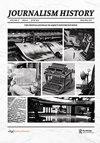Teaching Tragedy: Media History Courses and 9/11
Q4 Social Sciences
引用次数: 2
Abstract
Since the early 2000s, media historians have grappled with how to teach the memory and continuing legacy of 9/11 through the journalism produced on that tragic day. Not unlike previous generations of teacherscholars, journalism history professors face the unique challenge of framing conversations about 9/11 in both respectful and complicating terms, challenging media narratives while also centering the value of journalism during national tragedies. And yet a typical media-history course ends at some point around or just after Watergate, a generation before 9/11. The ambitious among us may push on into the 1980s and 1990s. But most stop before the events of September 11, 2001, during which even our seniors and first-year graduate students were young children, toddlers, or, in some cases, infants. Starting last year, many of our first-year students will have been born long afterward. But there is so much to cover in a media-history class, especially if you start “at the beginning” with the American War for Independence (presuming that your course is about American media history). For some time, I have resigned myself to not getting there—after all, in history departments, surveys of U.S. history are routinely broken up into two or even three courses. But whether you teach an advanced group of students, first-year students, those in a dedicated media-history class, or in some other kind of class with a media history unit, including 9/11 is not just a wise investment of time, but critical for understanding the rest of this century.悲剧教学:媒体史课程与9/11
自21世纪初以来,媒体历史学家一直在努力研究如何通过在那个悲惨的日子里制作的新闻来教授9/11的记忆和持续的遗产。与前几代教师学者没有什么不同,新闻史教授面临着独特的挑战,即以尊重和复杂的方式构建关于9/11的对话,挑战媒体叙事,同时也在国家悲剧中集中新闻的价值。然而,一门典型的媒体历史课程在水门事件前后或之后的某个时刻结束,也就是9/11之前的一代人。我们当中的雄心壮志可能会延续到20世纪80年代和90年代。但大多数在2001年9月11日事件发生之前就停止了,在此期间,甚至我们的高年级学生和一年级研究生都还是年幼的孩子,蹒跚学步的孩子,或者在某些情况下还是婴儿。从去年开始,我们的许多一年级学生将在很久之后出生。但是,媒体历史课程要涵盖的内容太多了,特别是如果你从美国独立战争开始(假设你的课程是关于美国媒体历史的)。一段时间以来,我已经接受了自己无法做到这一点——毕竟,在历史系,美国历史调查通常被分成两门甚至三门课程。但无论你教的是高级学生、一年级学生、专门的媒体历史课程的学生,还是其他有媒体历史单元的课程,包括9/11不仅是对时间的明智投资,而且对理解本世纪余下的事情至关重要。
本文章由计算机程序翻译,如有差异,请以英文原文为准。
求助全文
约1分钟内获得全文
求助全文

 求助内容:
求助内容: 应助结果提醒方式:
应助结果提醒方式:


